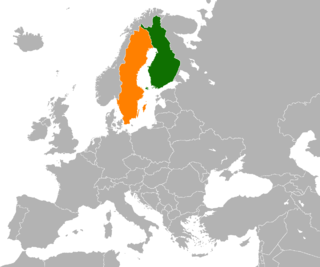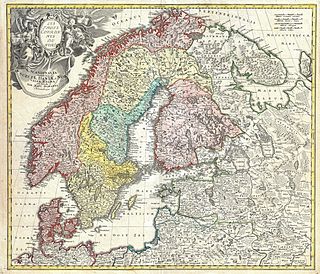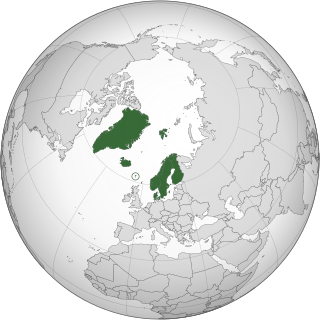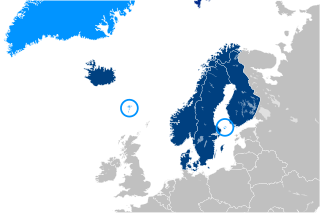
Scandinavia is a subregion of Northern Europe, with strong historical, cultural, and linguistic ties between its constituent peoples. Scandinavia most commonly refers to Denmark, Norway, and Sweden. It can sometimes also refer to the Scandinavian Peninsula. In English usage, Scandinavia is sometimes used as a synonym for Nordic countries. Iceland and the Faroe Islands are sometimes included in Scandinavia for their ethnolinguistic relations with Sweden, Norway and Denmark. While Finland differs from other Nordic countries in this respect, some authors call it Scandinavian due to its economic and cultural similarities.

The Swedish Armed Forces are the armed forces of the Kingdom of Sweden, tasked with the defence of the country as well as with promoting Sweden's wider interests, supporting international peacekeeping, and providing humanitarian aid. It consists of four service branches: the Swedish Army, the Swedish Air Force and the Swedish Navy, as well as a military reserve force, the Home Guard. Since 1994, all Swedish military branches are organised within a single unified government agency, the Swedish Armed Forces Headquarters, which is headed by the Supreme Commander, even though the individual services maintain their distinct identities.

The Scandinavian Peninsula is located in Northern Europe, and roughly comprises the mainlands of Sweden, Norway and the northwestern area of Finland.

The history of Sweden can be traced back to the melting of the Northern Polar Ice Caps. From as early as 12000 BC, humans have inhabited this area. Throughout the Stone Age, between 8000 BC and 6000 BC, early inhabitants used stone-crafting methods to make tools and weapons for hunting, gathering and fishing as means of survival. Written sources about Sweden before AD 1000 are rare and short, usually written by outsiders. It was not until the 14th century that longer historical texts were produced in Sweden. It is therefore usually accepted that Swedish recorded history, in contrast with pre-history, starts around the 11th century, when sources are common enough that they can be contrasted with each other.

The Nordic Council is the official body for formal inter-parliamentary Nordic cooperation among the Nordic countries. Formed in 1952, it has 87 representatives from Denmark, Finland, Iceland, Norway, and Sweden as well as from the autonomous areas of the Faroe Islands, Greenland, and Åland. The representatives are members of parliament in their respective countries or areas and are elected by those parliaments. The Council holds ordinary sessions each year in October/November and usually one extra session per year with a specific theme. The council's official languages are Danish, Finnish, Icelandic, Norwegian, and Swedish, though it uses only the mutually intelligible Scandinavian languages—Danish, Norwegian, and Swedish—as its working languages. These three comprise the first language of around 80% of the region's population and are learned as a second or foreign language by the remaining 20%.
The foreign relations of Norway are based on the country's membership in NATO and within the workings of the United Nations (UN). Additionally, despite not being a member of the European Union (EU), Norway takes a part in the integration of EU through its membership in the European Economic Area. Norway's foreign ministry includes both the minister of foreign affairs and minister of international development.

The Norwegian Army is the land warfare service branch of the Norwegian Armed Forces. The Army is the oldest of the Norwegian service branches, established as a modern military organization under the command of the King of Norway in 1628. The Army participated in various continental wars during the 17th, 18th, and 19th centuries as well, both in Norway and abroad, especially in World War II (1939–1945). It constitutes part of the Norwegian military contribution as a charter member of the North Atlantic Treaty Organization (NATO) since 1949.
Sweden had a policy of neutrality in armed conflicts from the early 19th century, until 2009, when it entered into various mutual defence treaties with the European Union (EU), and other Nordic countries. The policy originated largely as a result of Sweden's involvement in the Napoleonic Wars, during which over a third of the country's territory was lost in the Finnish War (1808–1809), including the traumatic loss of Finland to Russia, which it remained part of until Finland gained independence in 1917. Resentment towards the Swedish king Gustav IV Adolf, who had consistently pursued an anti-Napoleonic policy and thereby caused the war, precipitated a coup d'état known as the Coup of 1809. The new regime deposed the king and introduced the Instrument of Government (1809), later formulating a new foreign policy that became known as The Policy of 1812.

Finland and Sweden share a long history, similar legal systems, and an economic and social model. Finland was part of Sweden for almost 700 years from around 1150 until the Finnish War of 1809 after which Finland became an autonomous part of the Russian Empire as the Grand Duchy of Finland. Since Finland gained its full independence from Russia in 1917, Finland and Sweden have been close partners, enjoying a special relationship. The number of Finnish-Swedish connections and the quality of cooperation in most areas of the government is unique when compared to other international relations involving both countries. The Swedish language has an official status in Finland, whilst Finns form the largest ethnic minority in Sweden, estimated to be about 675,000.

The history of Scandinavia is the history of the geographical region of Scandinavia and its peoples. The region is located in Northern Europe, and consists of Denmark, Norway and Sweden. Finland and Iceland are at times, especially in English-speaking contexts, considered part of Scandinavia.

The military history of Finland consists of hundreds of years of armed actions in the territory encompassing modern Finland.

NATO is an international military alliance consisting of 32 member states from Europe and North America. It was established at the signing of the North Atlantic Treaty on 4 April 1949. Article 5 of the treaty states that if an armed attack occurs against one of the member states, it shall be considered an attack against all members, and other members shall assist the attacked member, with armed forces if necessary. Article 6 of the treaty limits the scope of Article 5 to the islands north of the Tropic of Cancer, the North American and European mainlands, the entirety of Turkey, and French Algeria, the last of which has been moot since July 1962. Thus, an attack on Hawaii, Puerto Rico, French Guiana, the Falkland Islands, Ceuta or Melilla, among other places, would not trigger an Article 5 response.

Iceland–Norway relations are foreign relations between Iceland and Norway. Iceland has an embassy in Oslo and Norway has an embassy in Reykjavík.

During the early stages of World War II, the United Kingdom and France made a series of proposals to send troops to assist Finland against the Soviet Union during the Winter War, which started on 30 November 1939. The plans involved the transit of British and French troops and equipment through neutral Norway and Sweden. The initial plans were abandoned because Norway and Sweden declined transit through their land for fear that their countries would be drawn into the war. The Moscow Peace Treaty ended the Winter War in March 1940, which precluded the possibility of intervention.

The Nordic countries are a geographical and cultural region in Northern Europe and the North Atlantic. It includes the sovereign states of Denmark, Finland, Iceland, Norway and Sweden; the autonomous territories of the Faroe Islands and Greenland; and the autonomous region of Åland.

Norway–United Kingdom relations are foreign relations between Norway and the United Kingdom. The two nations have enjoyed very close cultural, economic, military and political cooperation since Norwegian independence in 1905. Both countries are central allies in NATO, and also have many bilateral agreements involving trade and military ties. Recently, the two have collaborated extensively to provide intelligence and arms to Ukraine during Russia's invasion of that country in 2022.
Nordvision is a cooperative venture, established in 1959, between five Nordic public service broadcasters: Denmark's DR, Norway's NRK, Iceland's RÚV, Sweden's SVT and Finland's YLE. Sweden's SR and UR, Greenland's KNR and the Faroe Islands' KVF are associate members.

The Nordic Defence Cooperation (Nordefco) is a collaboration among the Nordic countries in the area of defence. Its five members are Denmark, Finland, Iceland, Norway, and Sweden.

The Arctic Policy of the Kingdom of Denmark defines the Kingdom's foreign relations and policies with other Arctic countries, and the Kingdom's strategy for the Arctic on issues occurring within the geographic boundaries of "the Arctic" or related to the Arctic or its peoples. In order to clearly understand the Danish geopolitical importance of the Arctic, it is necessary to mention Denmark's territorial claims in areas beyond its exclusive EEZ in areas around the Faroe Islands and north of Greenland covering parts of the North Pole, which is also claimed by Russia.
The 1948 Easter Crisis was the fear that the Soviet Union or Soviet-aligned Communists were planning an invasion or coup d'état in Denmark, in the wake of the 1948 Communist Coup in Czechoslovakia. Until this crisis, Denmark had tried to remain neutral between East and West, but in the election of 1947, the Communists had been reduced from 18 to 9 seats in the Folketing, removing them from participation in the parliamentary defence and security committee. It was now possible for defence to be discussed without any Communist intervention. Growing fear of attack from the East caused Denmark's government led by Hans Hedtoft to align with the West. After an abortive attempt to form a Scandinavian defence union with Finland, Iceland, Norway and Sweden, Denmark joined NATO in 1949.
















